

A day trip to Hiroshima is something many visitors to Japan want to do. It can easily be done from Kyoto, Osaka or Kobe.
This is our itinerary from our day trip to Hiroshima from Kyoto. Please be aware that this itinerary involves a lot of walking, so make sure you wear comfortable shoes and take water with you.
On 6 August 1945, United States airmen dropped a nuclear bomb which they called “Little Boy” on the Japanese city of Hiroshima. Three days later, on 9 August 1945, a second nuclear bomb which they called “Fat Man” was dropped on Nagasaki.
The Little Boy bomb, dropped from the Enola Gay was a uranium fuelled bomb. It exploded about 2,000 feet above Hiroshima. At that time, it released nearly 16 kilotons of explosive force. To give perspective to this, 16 kilotons is equivalent to 16,000 tons of TNT.
The damage from the Little Boy bomb was immense as Hiroshima is located on a plain. As a result, the force to spread further than in Nagasaki, which is located in a valley. However, as the bomb was detonated high up in the atmosphere, the radioactive fireball (or mushroom cloud) did not touch the ground. Rather it travelled up high into the stratosphere. But the damage to Hiroshima was still devastating. The blast flattened buildings within a 2.5 km radius of the bomb’s detonation point. Only 28,000 thousand of the original 90,000 buildings remained after the blast.
Hiroshima Peace Memorial Museum Graphic of the Bombing
But, what many people may not realise is that just over a month after the bombing of Hiroshima, the city was hit by Typhoon Ida which further devastated the city with even more damage and deaths.
Today Hiroshima is a thriving modern city with over 1.475 million people living there.
Tsutomu Yamaguchi survived both the bombs in Hiroshima and Nagasaki and lived to the ripe old age of 93. You can read more about him here.
So is it safe to visit Hiroshima? In a simple answer, yes. But let me explain in a bit more detail.
At the moment of the detonation of the bomb, the initial radiation caused extensive damage to the human body with most of those within a 1 km radius receiving direct radiation and dying immediately. However, about 80% of all residual radiation was emitted within 24 hours. Within a few weeks the radiation had declined rapidly. 24 hours after the bombing a person would receive 1/1000th of the amount of radiation a person at the epicentre would have received at the time of detonation. Within a week that had reduced to 1/1,000,000th. After that, radiation continued to decline.
To clarify, today the radiation in both Hiroshima and Nagasaki is equivalent to the low levels of background or natural radiation present anywhere on Earth. It has no effect on humans, animals or the environment.
Firstly, yes you can use your JR Pass to get from Kyoto to Hiroshima. You can get to Hiroshima on either the Tokaido or Sanyo Shinkansen lines from Kyoto Station and arrive at Hiroshima Station. The train takes 1 hour and 40 minutes. However, the faster Nozomi Shinkansen train which reaches Hiroshima in 1 hour and 15 minutes from Kyoto is not covered by the JR Pass.
If you are heading to Hiroshima from Osaka using a JR Pass, you can catch a Sakura train which will take 1 hour and 32 minutes. However, the faster Mizuho and Nozomi trains are not covered by the JR Pass (they take 1 hour and 25 minutes).

When you leave the Hiroshima Station, you will see the tram station. If you are only heading to the Memorial Peace Park, it is cheaper to buy single tickets at Y180 one way. However, if you are interested in exploring more of the city, you can buy a one-day ticket which was more cost effective at Y600 for adults. We took the one-day ticket option for the below itinerary.
When using the one-day ticket, scratch off the date that you are using the pass on the sealed silver section of the calendar. Make sure you don’t scratch off more than one date as this will make your ticket invalid.
The platforms are clearly marked. When the tram arrives, the doors will be marked with either Entrance or Exit. Make sure you get on through a door marked Entrance. When you hear your destination station announced (you can follow where you are with maps on the tram), press the buzzer by the window to let the driver know you want to leave at that station.
As you leave, show the scratched side of your one-day pass to the driver or the conductor.
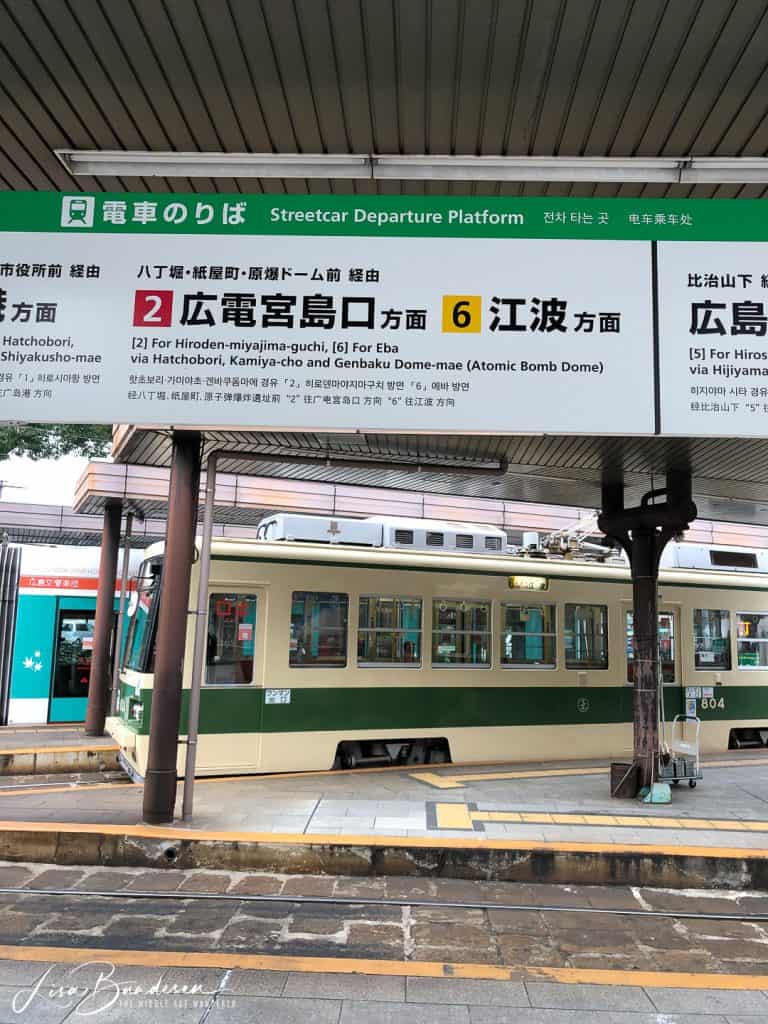
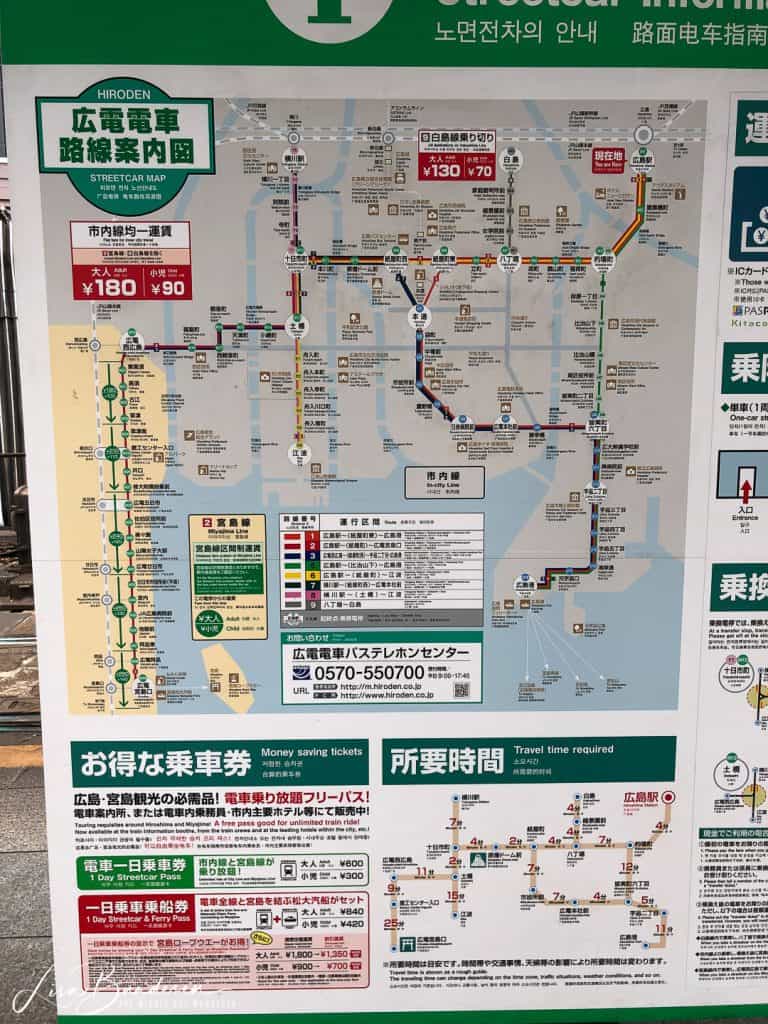
Part one of my day trip to Hiroshima itinerary is about remembrance and reflection – remembrance of the horrific effects war has on people and the environment in which we live and reflection of how the city has become a beacon of peace.
All 12 locations are within easy walking distance of each other.
Take either the Red Line (Line 2) or the Yellow Line (Line 6) from Hiroshima Station to Tenbaku Dome-mae stop (the Atomic Bomb Dome).
The tram trip takes about 17 minutes and gives you time to sit back and take in your first real views of this metropolitan city. As I stared out the window of the tram, I did not see any signs of the impact of the atomic bomb on the city. But, it was not until we disembarked from the tram that the true impact of the atomic bomb could be seen as the Atomic Bomb Dome came into view for the first time.
Take the pedestrian crossing from the tram stop across to the Atomic Bomb Dome park.
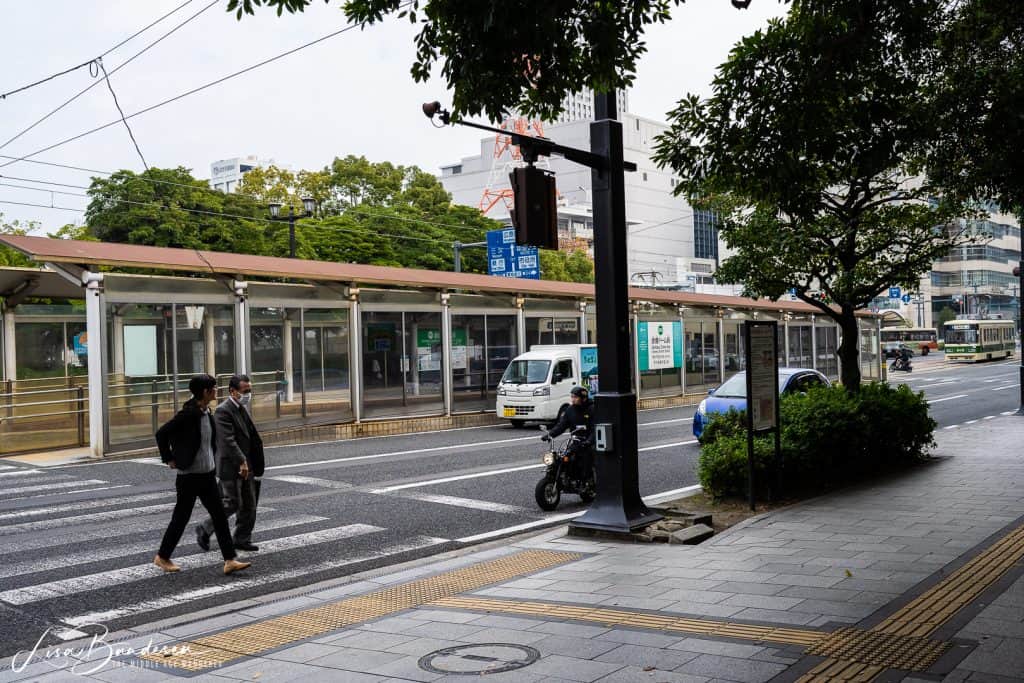
The Red Bird Monument is a literary monument dedicated to Miekichi Suzuki and is actually made up of two statues.
Miekicki Suzuki (1882 – 1936) was born in Hiroshima and was a distinguished novelist. He created a children’s literature magazine from which this statue takes it’s name – Akai Tori or The Red Bird. The magazine was published between 1918 and 1936. As a result of his contributions to children’s literature in Japan he became known as the “Father of Children’s Literature”.
The monument shows Mr Suzuki holding two birds with another on his shoulder and includes the logo of the magazine along with the title Akai Tori. The inscription on the second monument with two small children sitting on top of the stone reads “I will forever dream, simply as I did in my boyhood, and therefore suffer only little. Miekichi”.
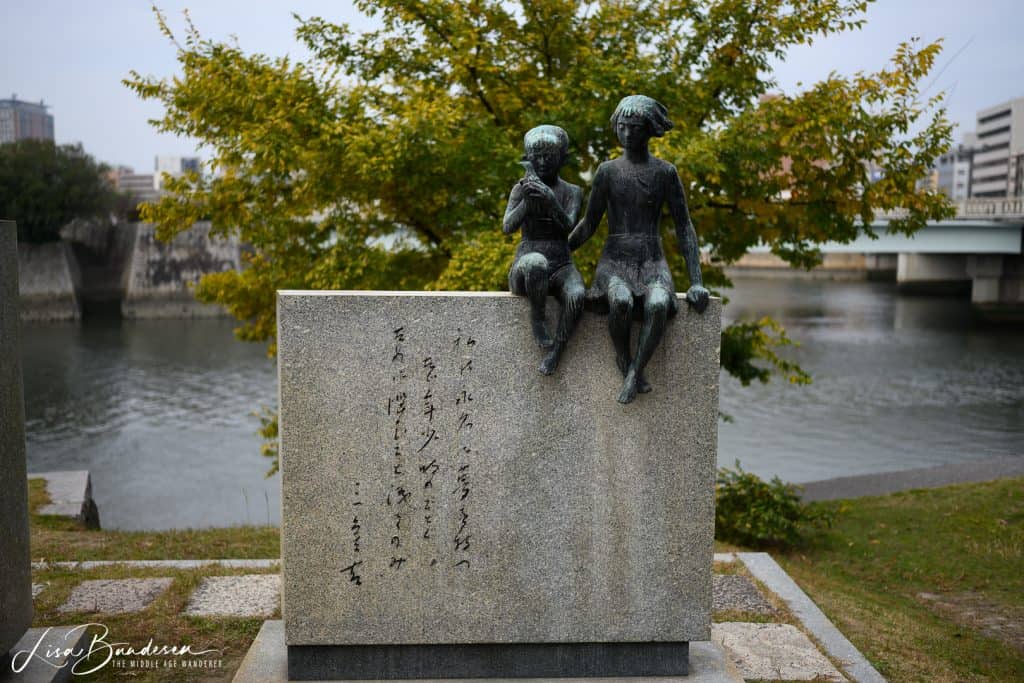
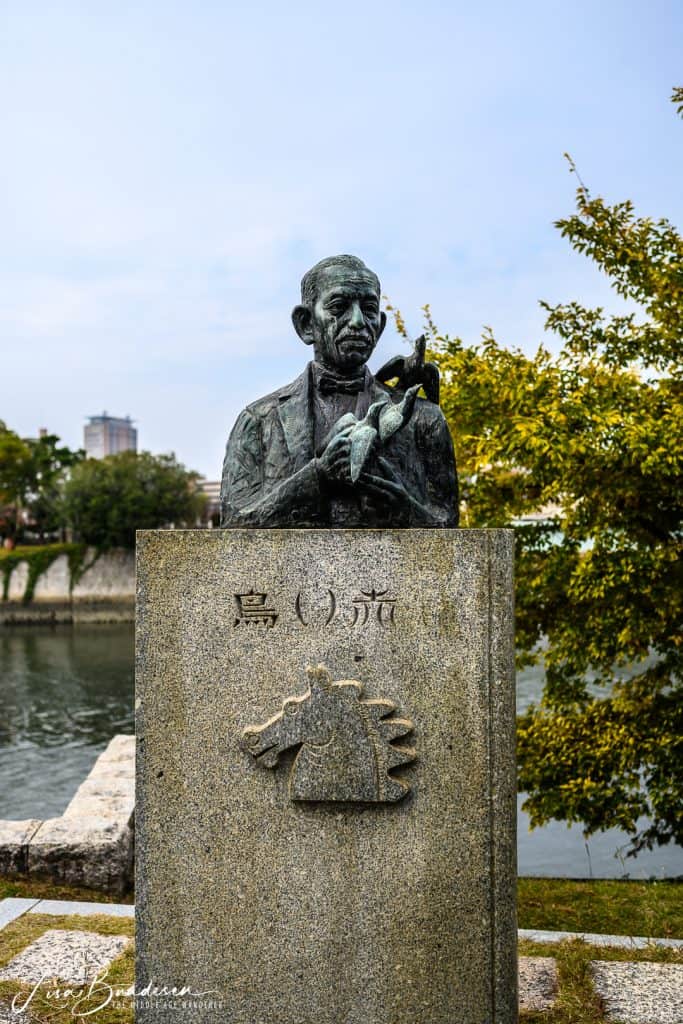
The Atomic Bomb Dome or Genbaku Dome was originally the Hiroshima Prefectural Industrial Promotion Hall. It was designed by Czech architect Jan Letzel and was completed in April 1915.
The building escaped complete destruction because the bomb detonated almost overhead, but the people inside died and the interior of the building was destroyed. In December 1996, the Atomic Bomb Dome was added to the UNESCO World Heritage List so it must be maintained in the exact state of destruction that the bomb caused. It was included on the World Heritage List as it survived a destructive force (being the first nuclear bomb used on a human population) and as it is now seen as a symbol of peace.
Take your time to walk around the building and reflect on the destruction caused by the bomb.
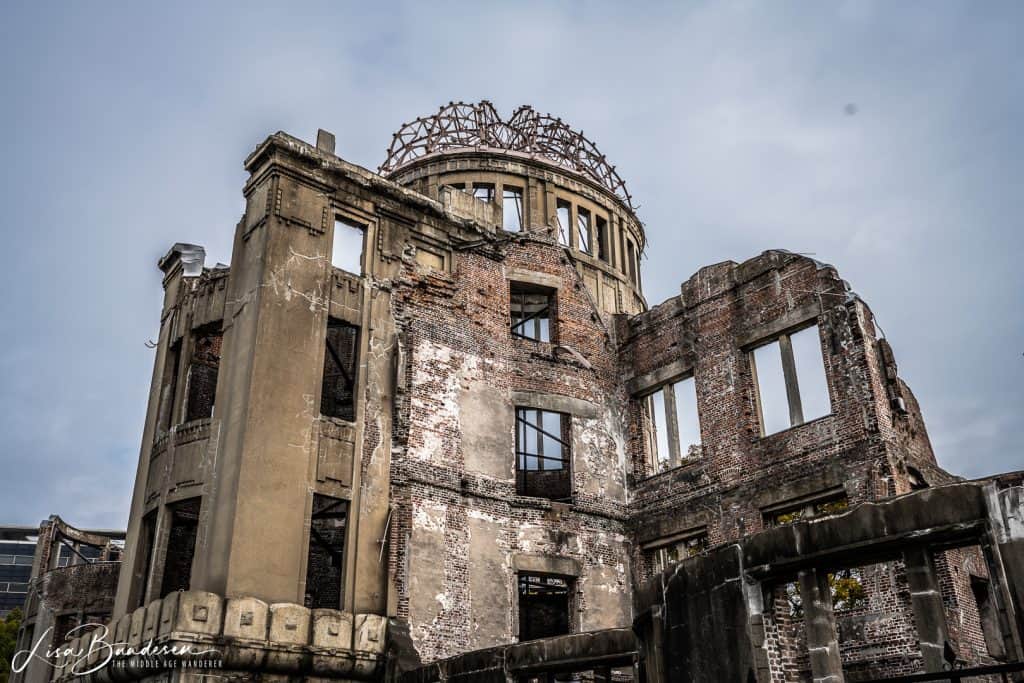
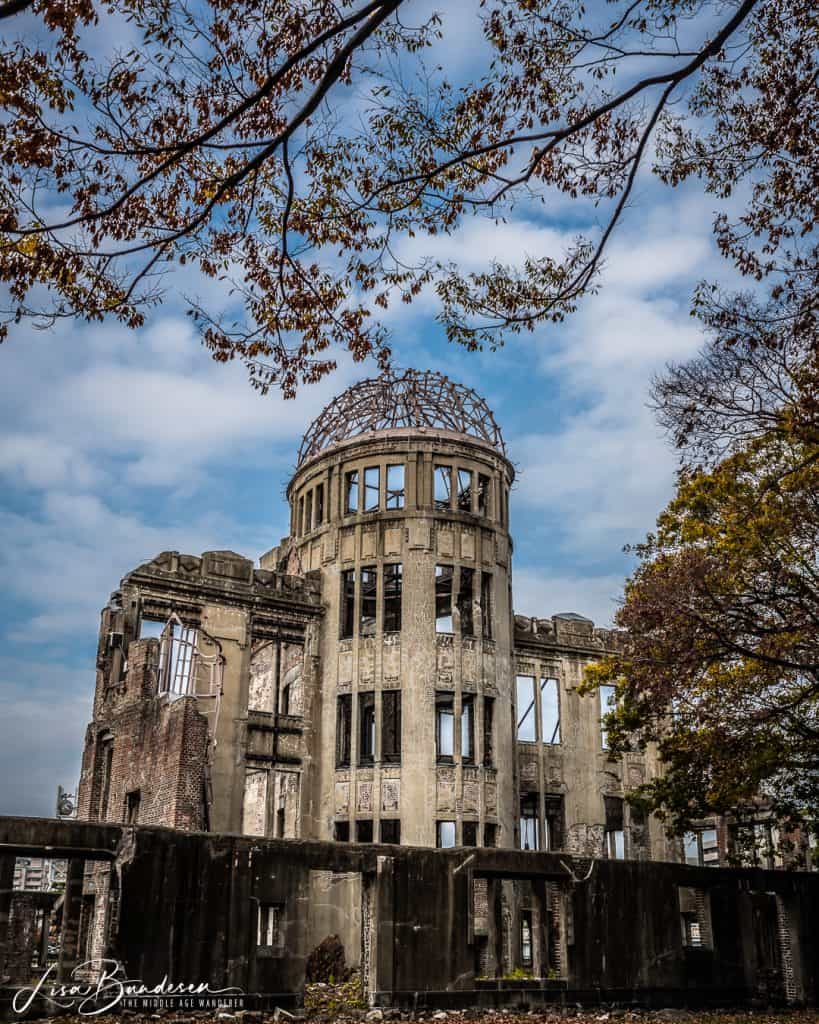
In August 1944, about 12 months before the Atomic Bomb was dropped on Hiroshima, the government recognised a labour shortage and enacted the Student Labour Service Act. It required students in middle school and higher grades to work in munitions factories. By November of 1944 students were also required to tear down buildings to create fire breaks so fires from air attacks would not spread. On the day of the bombing, around 8,400 students were in the city. About 6,300 died on the day of the bombing.
Bereaved families began a movement to create a list of the students killed in the bombing and funds donated enable the Memorial Tower to be built.
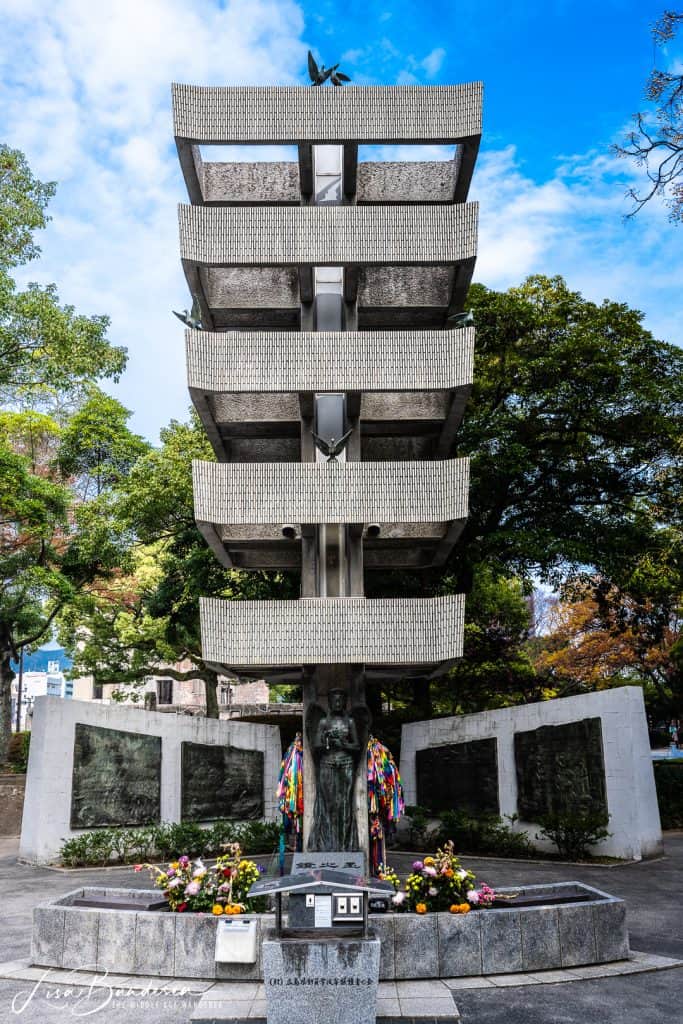
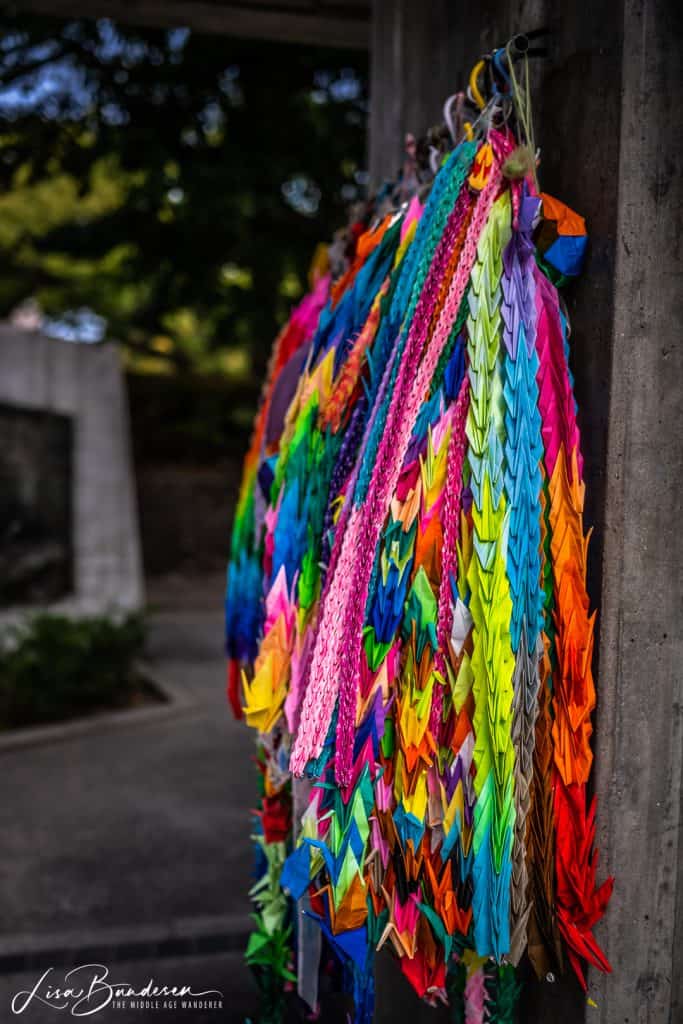
The Atomic Bomb Dome was not, as popularly thought, the hypocentre of where the bomb exploded. It actually detonated 160 metres to the southeast. The recognition of it being the site of the Hypocentre is marked only by a plaque which shows a photo of the devastation and facts of the event.
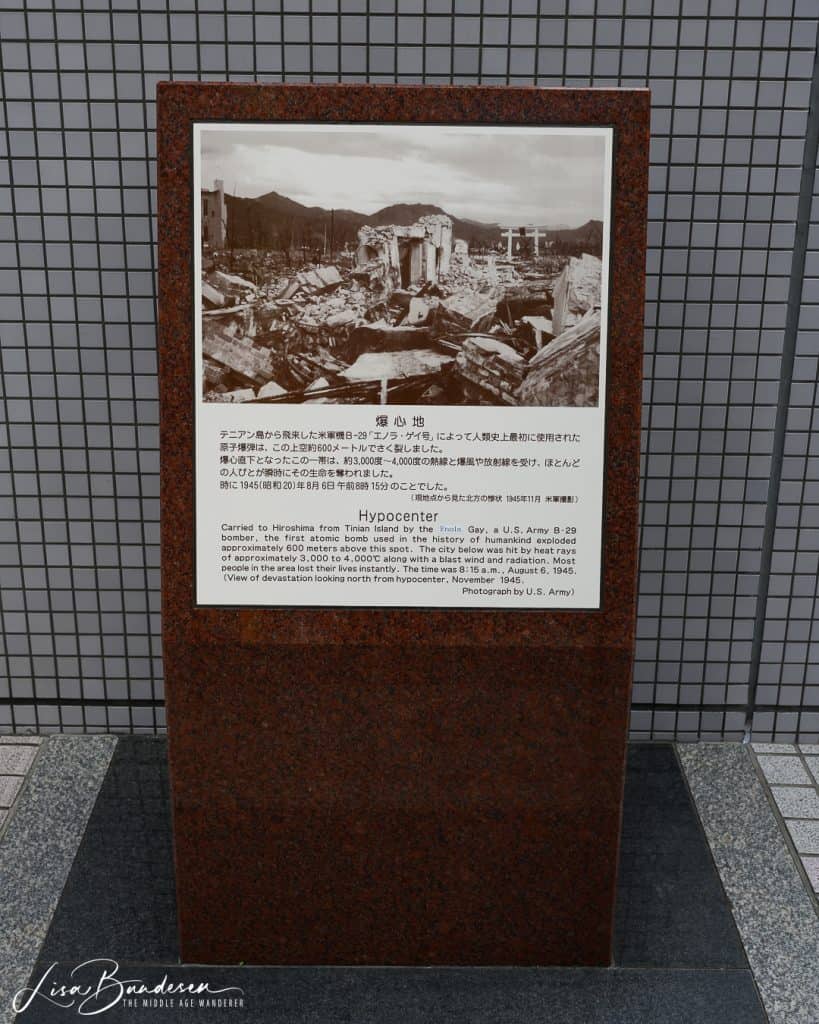
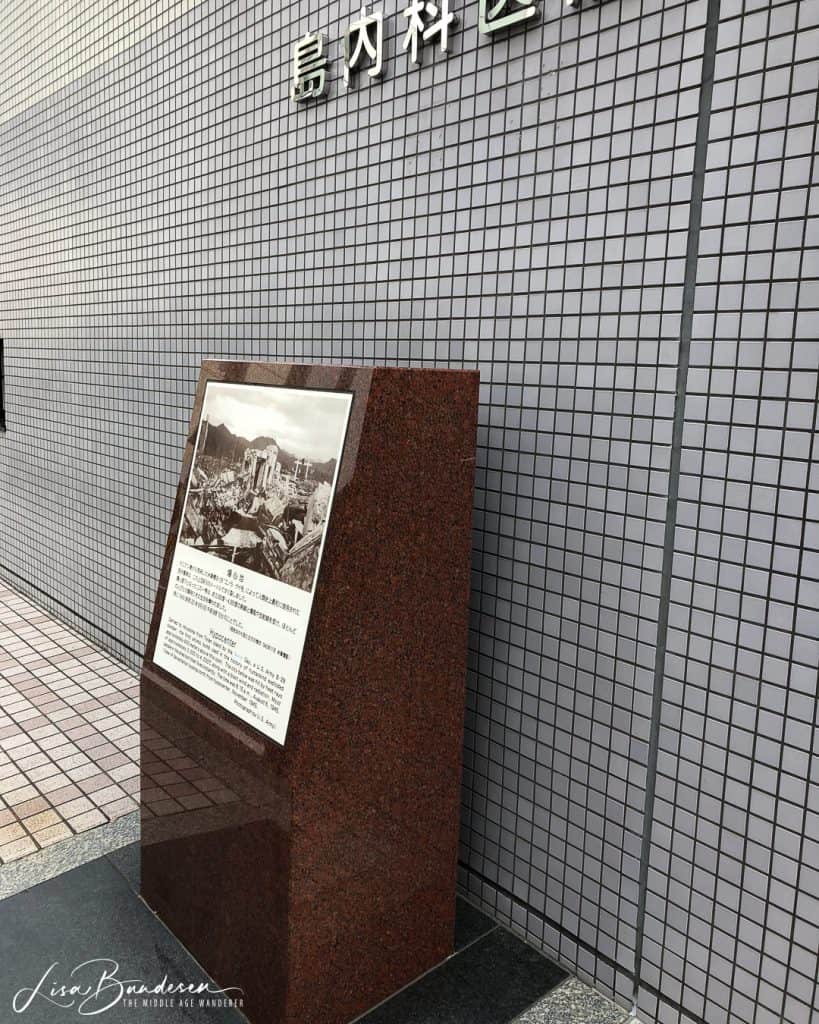
The Children’s Peace Monument or the “Tower of a Thousand Cranes” was built in honour of Sadako Sasaki. Sadako was just two years old when the bomb was dropped on Hiroshima and she was exposed to radiation. However, at the age of 12, on 25 October, 1955 she died from leukaemia, having been diagnosed at the age of 11.
Sadako decided to fold 1,000 paper cranes as she believed if she did, she would recover. The crane is a symbol of longevity and happiness. But she died before she could complete her goal. After her death, her classmates folded the rest.
Her death triggered a campaign to raise funds for a monument to pray for the thousands of children who were killed by the bombing and to pray for world peace.
Sadako’s story spread around the world and now over 10 million cranes are sent to the Children’s Peace Monument every year. These are stored in glass cases around the monument. As more paper cranes arrive, the older cranes are removed. These old cranes are recycled into postcards and you will receive one when you visit the Peace Memorial Museum.
When visiting the monument, you are able to place a paper crane at the monument.
On top of the monument, you will see a statue of a girl holding a crane. On each side are two other figures, one of a girl and one of a boy. They symbolise a bright future and hope. Under the dome is a bell with a gold crane. You can enter the dome and ring the bell. A stone plague underneath reads “This is our cry. This is our prayer. For building peace in this world.”
The cenotaph was designed by Kenzo Tange in 1952. At the time he was a professor at the University of Tokyo who wanted to rebuild Hiroshima.
The shape of the roof was designed to reflect the shape of an ancient Japanese clay house which would allow the souls of the bombing victims to be sheltered from the rain.
The stone chamber underneath the roof holds the registry of the names of all of the victims of the bombing, regardless of nationality. As at 6 August, 2016 the registry held 111 volumes. 110 volumes contain the names of 303,195 victims. The 111th volume contains the words “Many victims with their names unknown”. However, names can be added to the registry when an application is made by a relative of a deceased victim.
The stone at the centre of the cenotaph is inscribes with very poignant words:
“Let all the souls here rest in peace,
for we shall not repeat the evil.“
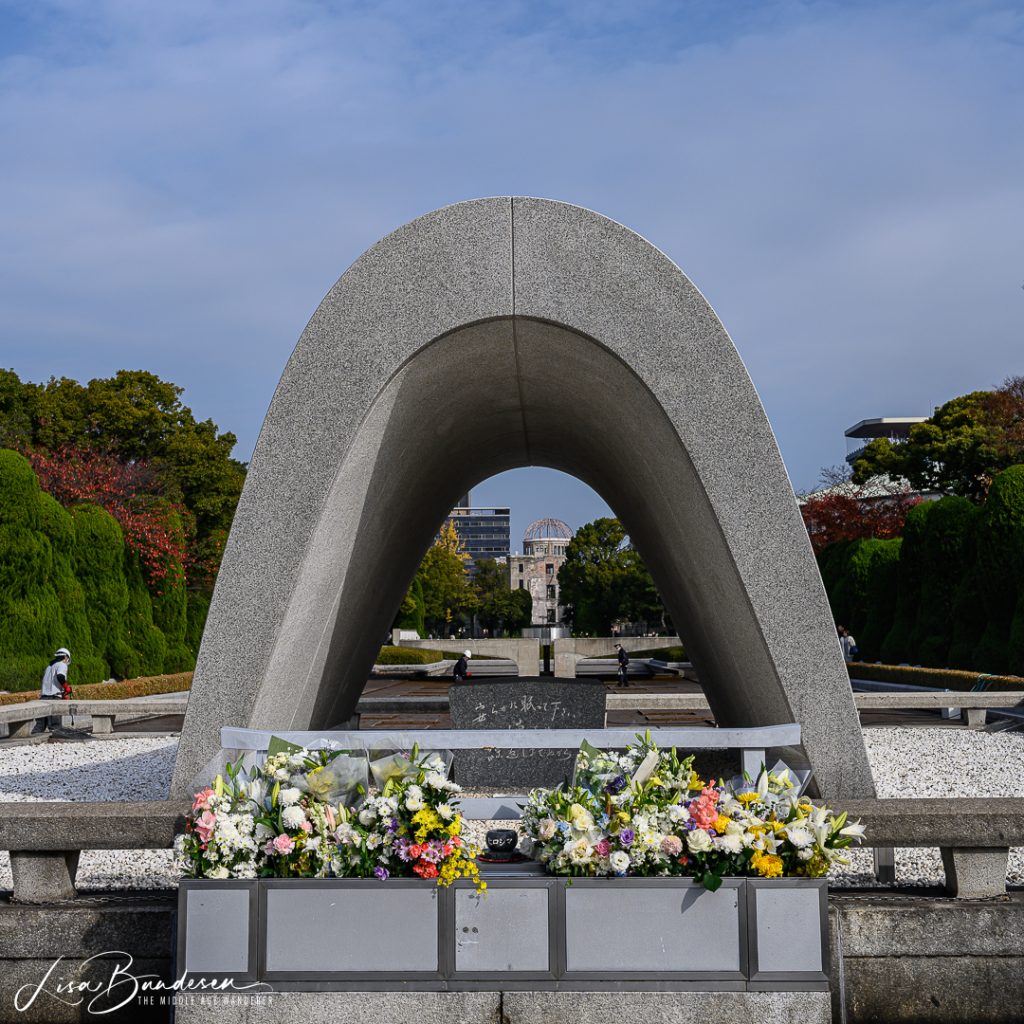
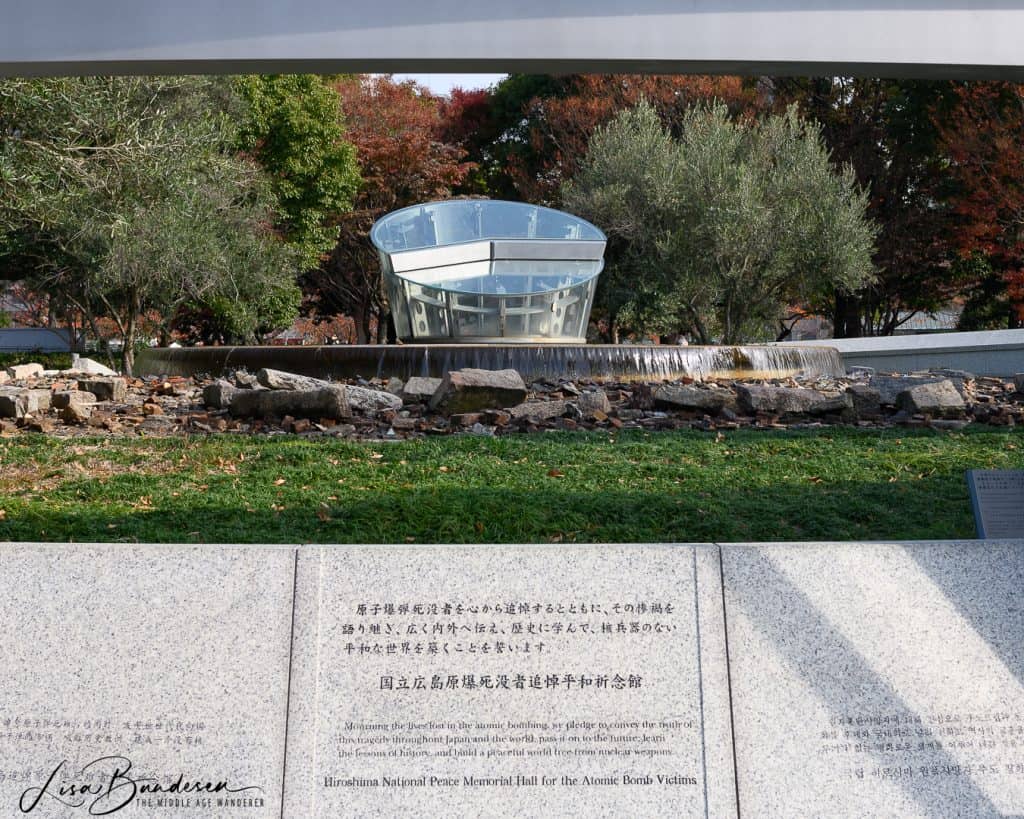
The Hiroshima National Peace Memorial Hall for the Atomic Bomb Victims was established in 2002 by the Japanese government. The government wanted to provide a place to mourn the victims of the bombing. But it also wanted to convey the tragic impact to the world ensuring future generations learn from the experience.
The Hall of Remembrance provides a place to quietly reflect on those who died as a result of the bombing as well as the hope of peace. The Hall is a circular room which shows the Hiroshima sky line from the hypocentre. In addition, the image is made up of 140,000 tiles, the number of victims.
There is also a Victims’ Identification Area which allows you to search for the names of people who died. 12 large screens display the photos and names of the victims. However, visiting the room is definitely confronting and very sobering. While many of the other monuments show the effects of the bomb, to see the names and faces of victims is distressing.

The museum is a place to see the reality of the atomic bomb.
The museum also contains items that survived the bombing such a watch that stopped at the exact time the bomb detonated. It also has a collections of letters from the bomb-making engineers pleading with the President of the United States not to use it.
The image of the tricycle is probably one of the most famous from the museum. A four year old boy was riding the tricycle when the bomb detonated. The blast burned him to death but left his burned and fused tricycle as a reminder of the devastation of the bomb.
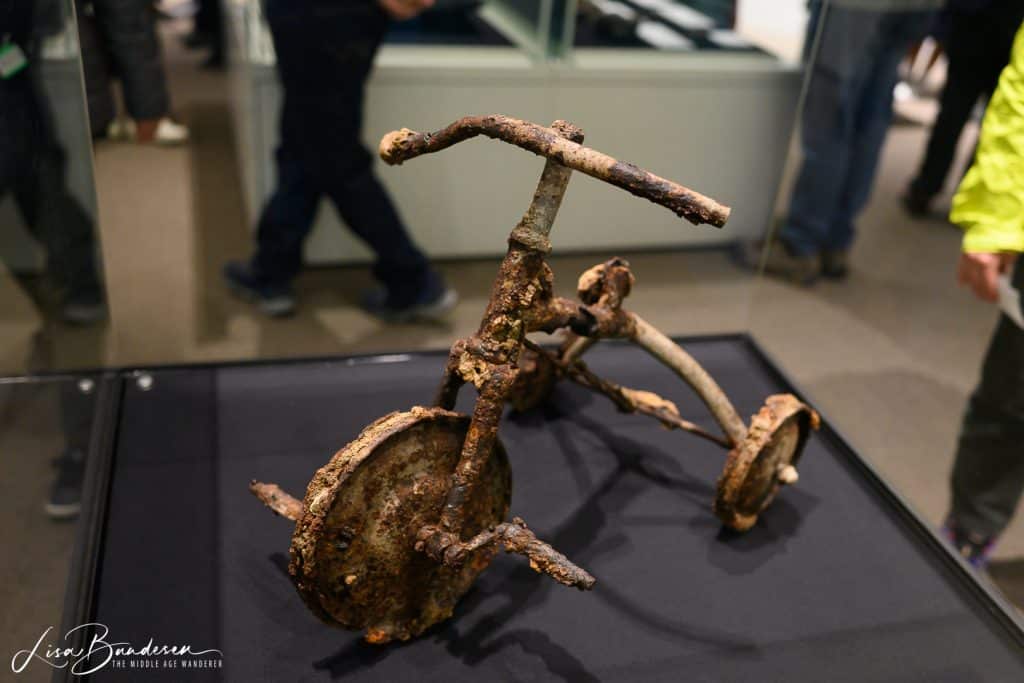
The Atomic Bomb Memorial Mound is the final resting place of the ashes of around 70,000 people who lost there lives on 6 August 1945. Of the 70,000 whose ashes are held in an underground vault, only 817 have been identified. However, the ashes remain unclaimed as entire families perished leaving no one alive to claim the remains.
After the bomb exploded, the area around the hypocentre of the explosion was stewn with the bodies of the victims. The bodies were brought to this location where they were cremated. A temporary vault was build to store the ashes. But in 1955 the vault was rebuilt and the ashed of unclaimed victims that had been stored in other locations, were brought here.
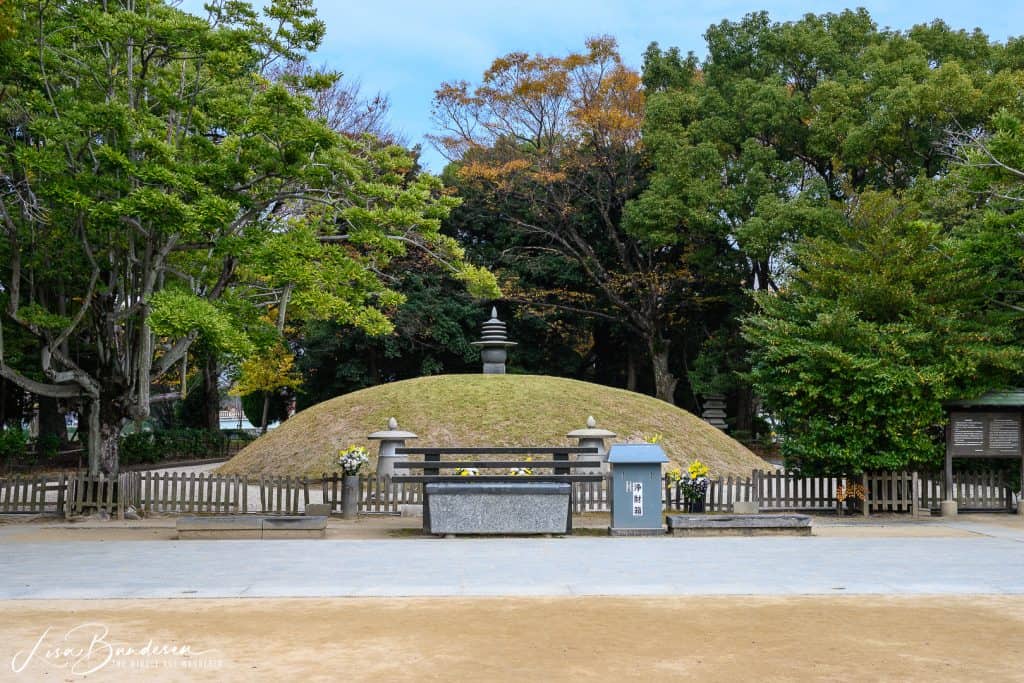
The Peace Bell was built in 1964 as a symbol of a world without nuclear weapons and wars. The bell is inscribed with a world map which symbolises one world as it has no national boundaries.
You are able to sound the bell by swinging the wooden log. Where the log hits is the atomic energy symbol to show hope for the abolition of atomic and hydrogen bombs. On the opposite side of the bell is an embossed mark to indicate a mirror reflecting the heart of the person sounding the bell.
The pond around the bell contains Oga Lotus. Lotus leaves were used by victims to reduce the pain of burns. These lotus were grown from seeds dug up from 2000 year old ruins in Chiba City by Professor Ichiro Oga.
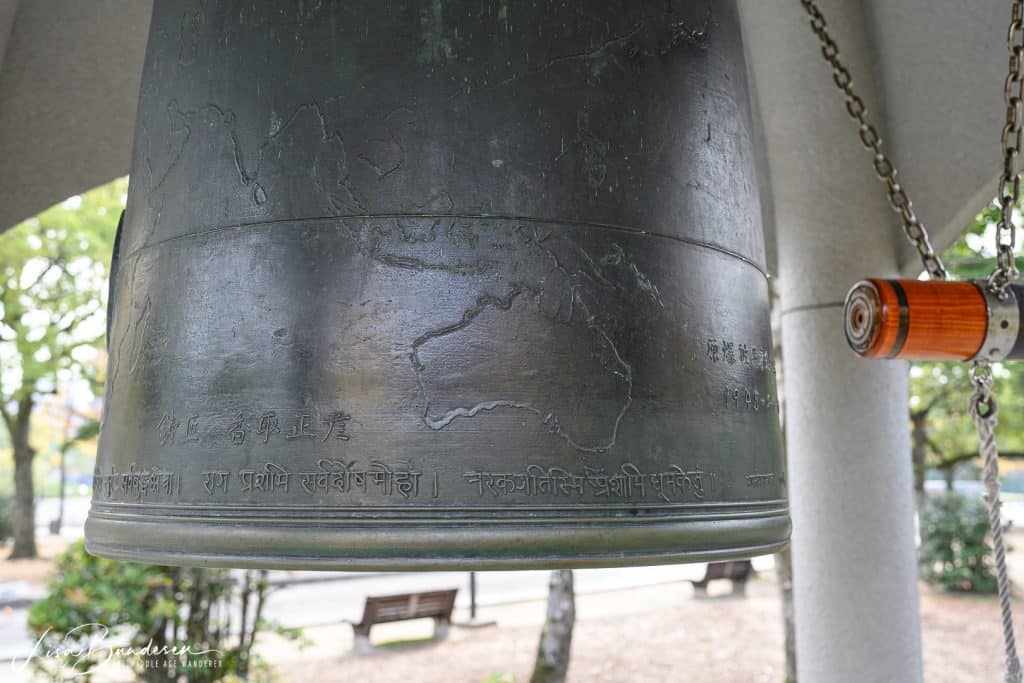
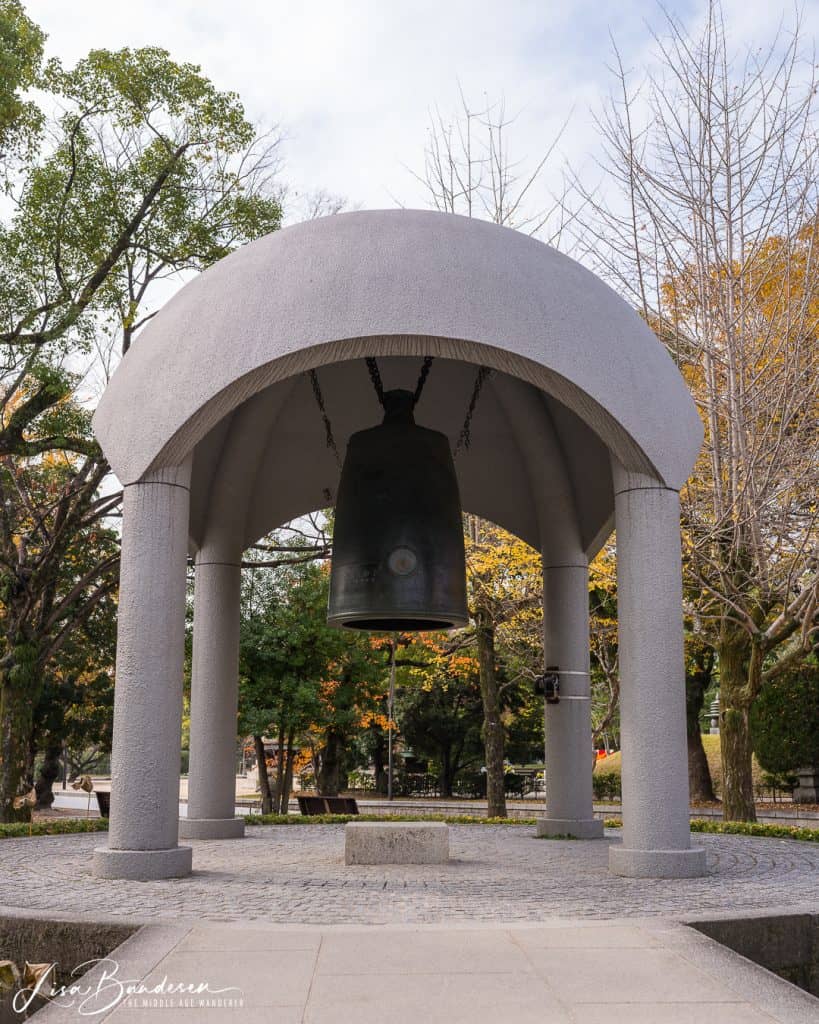
The tower is made of three iron pillars each twisted by 60 degrees. At the top is a spherical clock which faces in three directions. It stands 20 metres tall.
The clock chimes at exactly 8.15 am every day (the time the bomb detonated over the city).
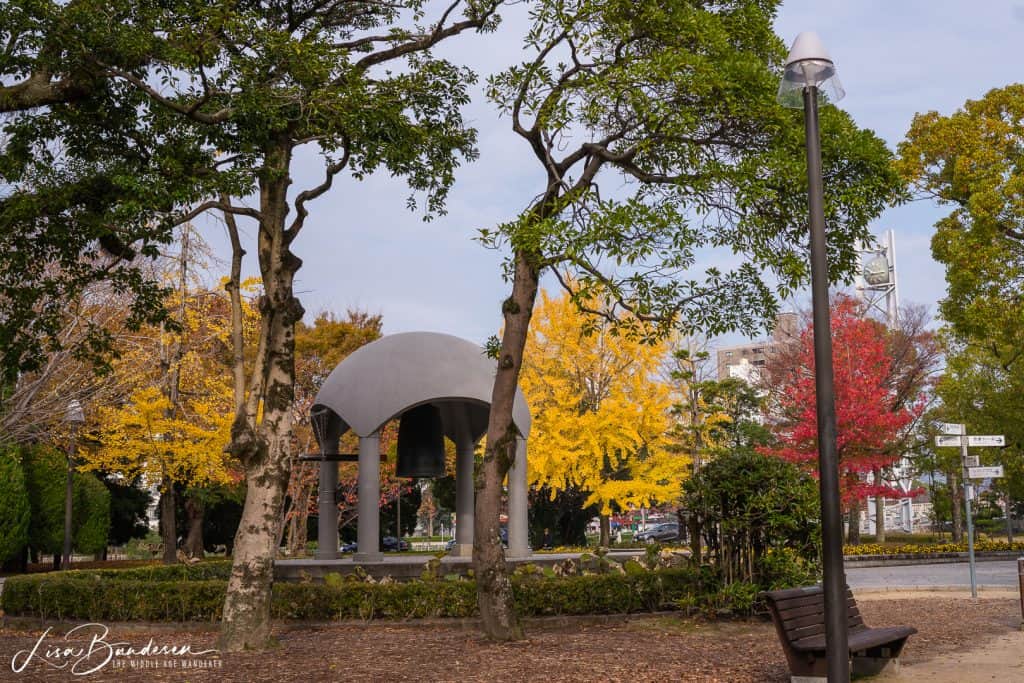
Part 2 of my day trip to Hiroshima itinerary is about history and tranquillity – history of Hiroshima before the bombing and the tranquillity of beautiful Japanese gardens. After spending the morning visiting sites dedicated to the devastation of the atomic bomb and the hope for peace you can see a different side of Hiroshima.
There are two ways to get from Part 1 of this itinerary to Part 2. The first is to walk (this is the option we took). It is about 1.7km from the Peace Clock Tower to Marunaka Supermarket where you can grab some lunch. If you decide on the tram option, walk to the Hondori Station and catch the Astramline to Johoku Station.
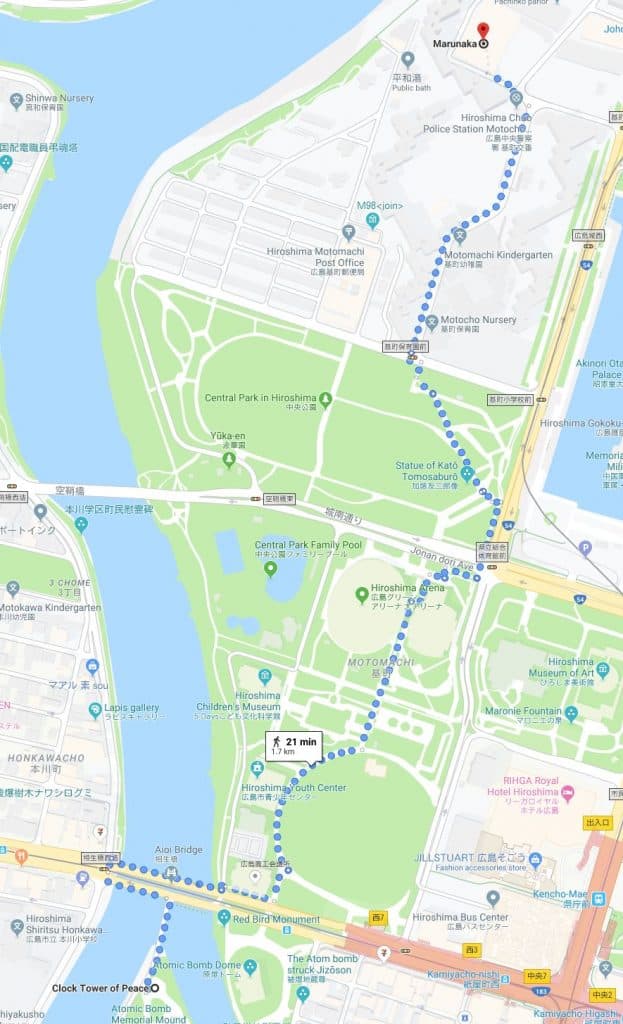
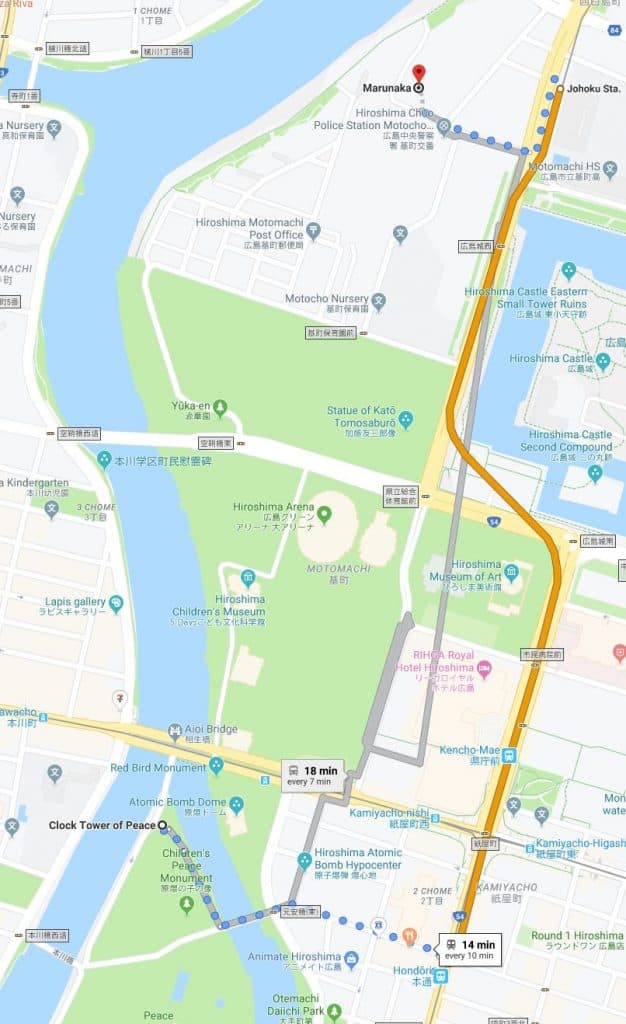
By now you should be getting hungry and it should be around time for lunch. One of the things we love doing when travelling is to see how people live their everyday lives. What better way to do that then to shop at a local supermarket. We spent some time wandering around the supermarket recognising some things and having no idea what other items were.
We then bought some food and drinks and headed to the park.
Now is the time to sit down on a park bench and give your feet a much earned rest. In addition, it gives you a chance to enjoy this view. We spent about 30 minutes here enjoying our lunch. While we weren’t sure what everything was we had bought, it all tasted great and we enjoyed our lunch.
It also gives you an opportunity to watch locals going about their daily lives. People were taking their dogs for a walk, going for a run, or simply enjoying the sunny day.
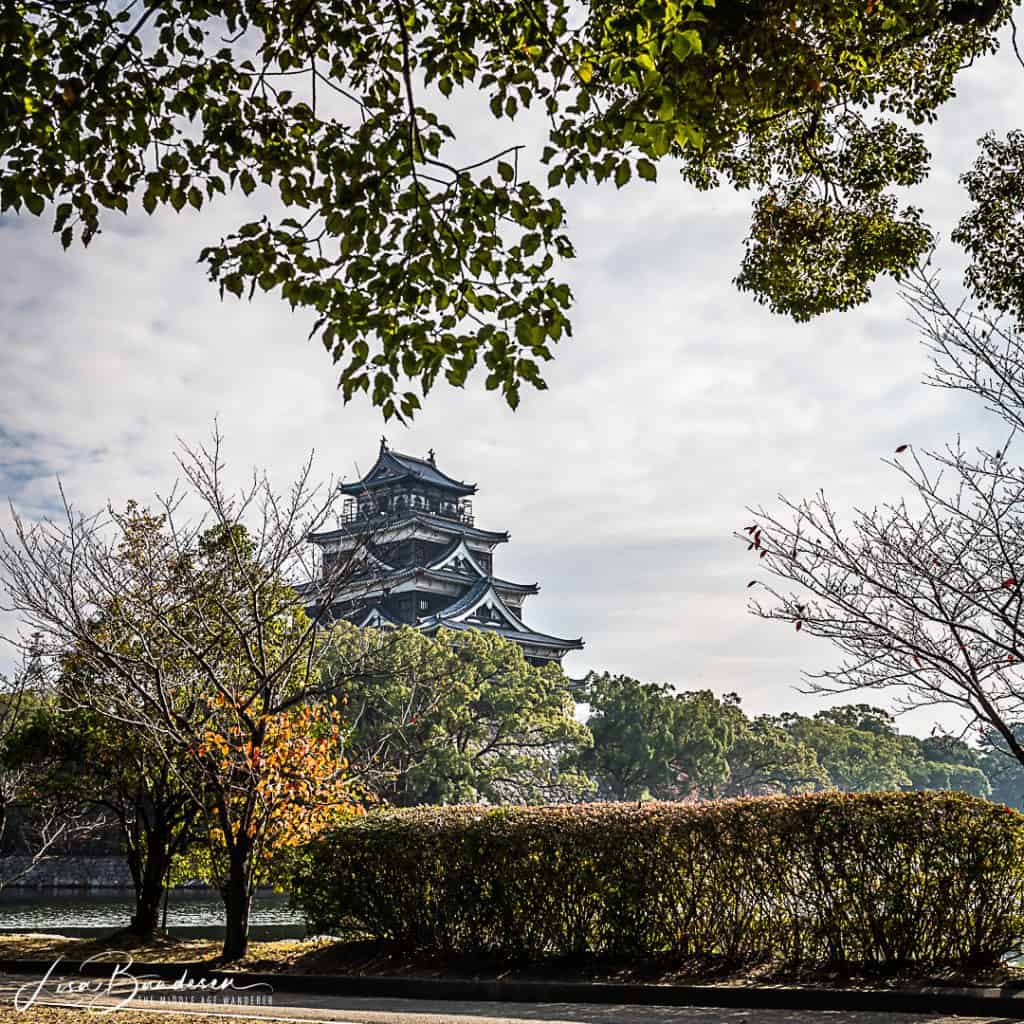
To gain access to Hiroshma Castle you will need to use the bridge to cross the moat. You will see on the map that the bridge is on the opposite side of the castle to the river.
The original castle that stood on this site dates back to 1589. However, the castle itself was only a small part of the overall area surrounded by three moats. However, over time the outer two moats were filled in leaving the moat you see today. The original castle was designated a National Treasure in 1931.
But on 6 August, 1945, like most of Hiroshima, the castle was destroyed. The grounds where the castle stood were designated a National Historic Site in 1953. After that, in 1958, the castle was reconstructed.
Take time to explore the grounds as you head to the castle. The castle is now a museum which displays items dating back to ancient Hiroshima over the bottom four floors. In addition, the fifth floor contains an observation platform for views over Hiroshima.
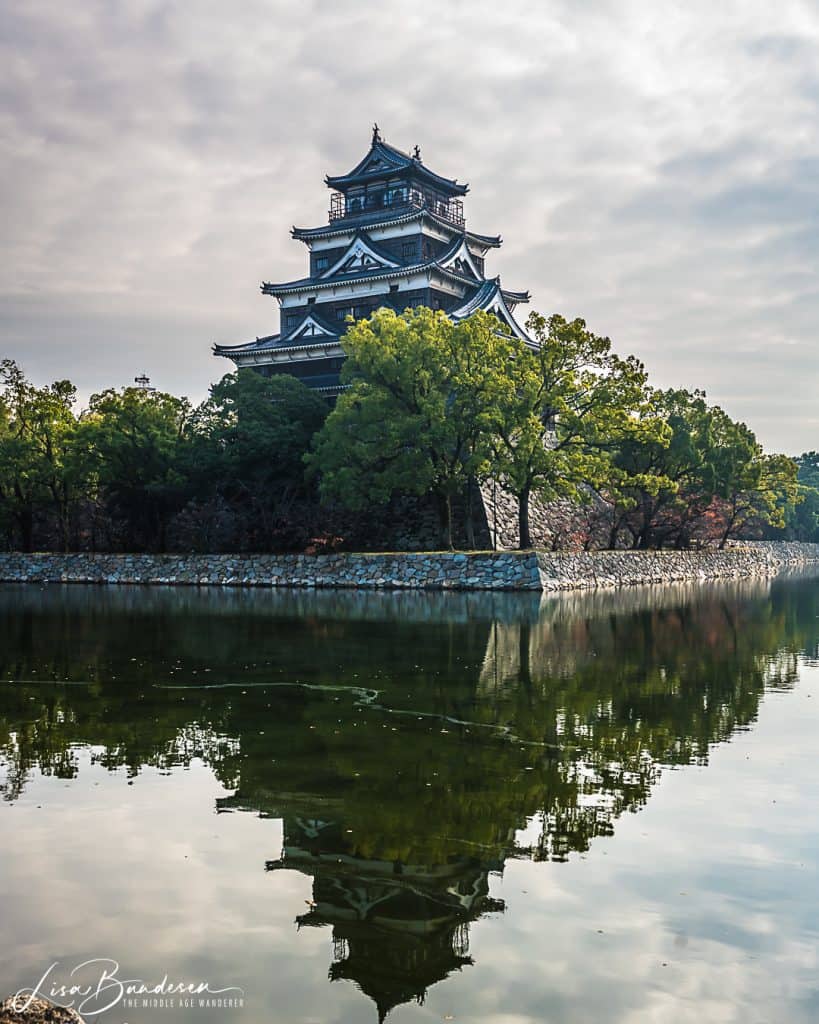

The easiest way to get from Hiroshima Castle to Shukkeien is to walk. It is about 1 km from the castle itself to the entrance of the gardens.
We wanted to visit the garden last on the day as after seeing the destruction of the atomic bomb, we felt the tranquillity of the gardens could help put what we had seen during the day into perspective.
The gardens date back to 1620, not long after Hiroshima Castle was built and were not open to the public until 1940. However, the public only had five years to enjoy the gardens because like almost everything in Hiroshima, it to was destroyed in 1945. It has since been restored to its original beauty.
Take your time to wander the gardens through inter-connecting pathways. Sit in one of the many tea houses around the gardens and enjoy the surrounds. Then if you wish you can enjoy a tea and Japanese sweets at the tea shop.
By this time we were pretty tired and our feet were definitely feeling how far we had walked. So it was a quick decision to catch the tram back to Hiroshima Station.
Walk to Shukkeien-Mae Station and catch the Grey Line two stations to Hatchobori. From Hatchobori you can then catch the Orange, Red or Yellow Lines (a tram runs every three mintues) back to Hiroshima Station for your trip back.
This itinerary involves a lot of walking, so you might like to read my 5 Foot Care Tips for Travelling.
About the Author – Lisa Bundesen
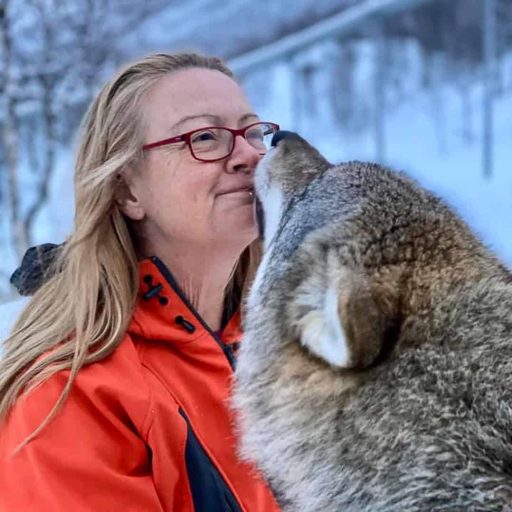
I’m a 50 something semi-retired accountant, who along with my husband, Darren, has worked hard to have a great career and be financially stable. Now it’s time to enjoy life more.
To enjoy life more, I’ve had to work hard to improve my fitness (I hiked the Inca Trail in my 40’s) and to keep fit to be able to do all of those things we want to do. That isn’t always easy because we also love to explore different cuisine and wine around the world and at home.
We travel as much as possible, both overseas and at home. We call Australia home and find that there are so many places to explore here as well.
But the main reason we return home from our adventures are our two beautiful girls, Jazz and Indy. Oh and yeah we both have work as well!
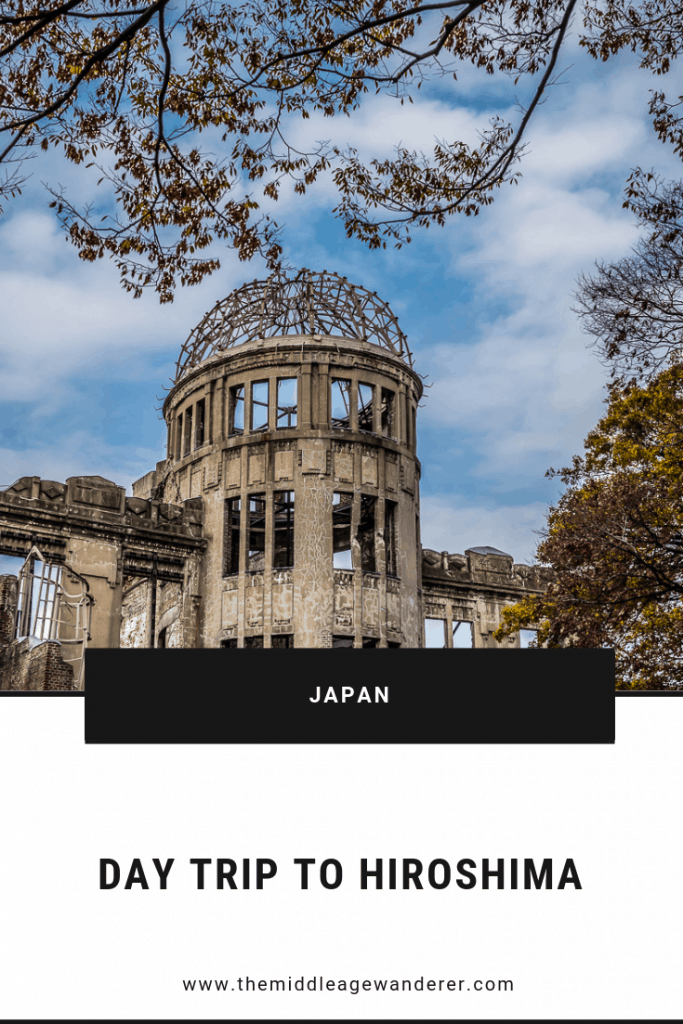

© 2024 The Middle Age Wanderer
Made with 


38 Responses
My first trip to Japan, I spent the entire week in Tokyo exploring every nook and cranny. Next time, Hiroshima is the first destination on my list. But it just seems like it would be so haunting
We loved exploring Tokyo too Kay. For me, visiting Hiroshima was more an opportunity to reflect and while there were definitely terrible parts to the visit, it also give you an opportunity to see how Hiroshima has taken what has happened and turned the city into a beacon of peace. I also think by finishing the day at the beautiful garden helps with that. The city is definitely worth visiting.
What an interesting place to visit! So very sad about all the people – and especially students who lost there lives. The stories behind all these attractions are so emotional to hear. Love this guide you’ve put together for all these places to see
Thanks Hayley. It is definitely an emotional experience visiting.
This sounds like such an intense and emotional experience. But I like how you ended your trip there with relfection in gardens. It looks so peaceful.
Thanks Meghan. It is definitely an emotional experience visiting and leaving the gardens to last gives you time to reflect on the day.
This is brutal. The kind of thing you don’t want to see but absolutely need to, I think. I remember the story of Sadako from when I was a kid. Hope I will get to place a paper crane by her memorial one day.
Sadako’s story is definitely inspiring Jenia. And I love how they take the older paper cranes and turn them into postcards for visitors to the museum.
The tricycle is such a sober reminder of this horrific event.
It really is Chris. I think it’s one of those photos that if you see it with no other reference you know exactly what it is.
What a moving experience. I did not have time to visit there when we went to Japan, but next time hopefully. It looks like it’s well worth the trip.
Very moving experience Kristina. Definitely worth visiting when you get back to Japan.
How amazing to visit Hiroshima. The gardens are so peaceful and lovely — makes it hard to imagine the horror of 1945.
Hiroshima is amazing to visit Sharon. We wanted to visit the garden last specifically to see the beauty after seeing the horror of the bombing.
Hiroshima is a special place to visit to keep memories alive. Thanks for your detailed information and great pictures.
It is definitely a special place Anita. It’s very surreal visiting.
Amazing that the radiation levels have reduced so much over relatively little time (I think some scifi shows might need some input from real scientists!).
I can only imagine the emotions felt visiting Hiroshima – that tricycle was enough for the tears to well …
When considering other nuclear disasters such as Chernobyl, Hiroshima is definitely a unique situation for radiation. And it is a really surreal experience. The tricycle is definitely one of those really heart wrenching items.
What a tragic but fascinating place to explore. It’s on my list for my next visit to Japan & this looks like a busy but very good itinerary. Thanks for sharing
Hi Sue. It’s definitely a busy itinerary but well worth the sore feet at the end.
These type of sites are important to see and experience. I recently went to Cambodia to delve into their war torn past. It was disturbing, but essential to see. Thanks for sharing, love how you’ve structured your post. thanks, Jay
Thanks so much Jay. We want to visit Cambodia also. As you said it really is essential to see and learn from these horrific events.
Hiroshima is such a great place to visit. Loved your blog post on it.
Thanks Bliss. It is definitely a beautiful city even with such a horrific past.
Hiroshima looks beautiful and so full of history! Thank you for sharing this. Really interesting post. I would love to visit the gardens so much!
Thanks Pauline. The gardens are a great way to finish a rather confronting day.
Something that we should all remember, great detailed guide to have to visit
Thanks Catherine. It is a full day but definitely worth the sore feet at the end.
Lisa, what a terrific blog. I really enjoyed reading it and it really appeals to my WW2 curiosity. Thanks for sharing.
So glad you enjoyed it Karen.
Very interesting post. We’re going to Japan next year and we are thinking about visiting Hiroshima, but we haven’t really made up our minds yet.
Thanks Amanda. It is definitely sombre to see parts of the city, but it is worth a day trip if you have the time.
The tricycle photo in the museum broke my heart. 😢I have yet to visit Japan and your guide will serve to be extremely useful.
Totally agree Christy about the tricycle. It was definitely emotional to see it.
This is such a meaningful post. Greatly appreciate this remembrance and reflection walking tour itinerary in Hiroshima.
Thanks!
Wow this post is so detailed – very helpful! Also I love the title of your blog, definitely struck a chord with me!
Thanks Val and so glad you like the theme of the blog 🙂